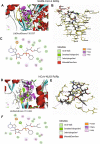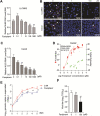Comparative assessment of favipiravir and remdesivir against human coronavirus NL63 in molecular docking and cell culture models
- PMID: 34873274
- PMCID: PMC8648821
- DOI: 10.1038/s41598-021-02972-y
Comparative assessment of favipiravir and remdesivir against human coronavirus NL63 in molecular docking and cell culture models
Abstract
Human coronavirus NL63 (HCoV-NL63) mainly affects young children and immunocompromised patients, causing morbidity and mortality in a subset of patients. Since no specific treatment is available, this study aims to explore the anti-SARS-CoV-2 agents including favipiravir and remdesivir for treating HCoV-NL63 infection. We first successfully modelled the 3D structure of HCoV-NL63 RNA-dependent RNA polymerase (RdRp) based on the experimentally solved SARS-CoV-2 RdRp structure. Molecular docking indicated that favipiravir has similar binding affinities to SARS-CoV-2 and HCoV-NL63 RdRp with LibDock scores of 75 and 74, respectively. The LibDock scores of remdesivir to SARS-CoV-2 and HCoV-NL63 were 135 and 151, suggesting that remdesivir may have a higher affinity to HCoV-NL63 compared to SARS-CoV-2 RdRp. In cell culture models infected with HCoV-NL63, both favipiravir and remdesivir significantly inhibited viral replication and production of infectious viruses. Overall, remdesivir compared to favipiravir is more potent in inhibiting HCoV-NL63 in cell culture. Importantly, there is no evidence of resistance development upon long-term exposure to remdesivir. Furthermore, combining favipiravir or remdesivir with the clinically used antiviral cytokine interferon-alpha resulted in synergistic effects. These findings provided a proof-of-concept that anti-SARS-CoV-2 drugs, in particular remdesivir, have the potential to be repurposed for treating HCoV-NL63 infection.
© 2021. The Author(s).
Conflict of interest statement
The authors declare no competing interests.
Figures






Similar articles
-
Structural Basis of the Potential Binding Mechanism of Remdesivir to SARS-CoV-2 RNA-Dependent RNA Polymerase.J Phys Chem B. 2020 Aug 13;124(32):6955-6962. doi: 10.1021/acs.jpcb.0c04198. Epub 2020 Jun 23. J Phys Chem B. 2020. PMID: 32521159
-
Stenoparib, an Inhibitor of Cellular Poly(ADP-Ribose) Polymerase, Blocks Replication of the SARS-CoV-2 and HCoV-NL63 Human Coronaviruses In Vitro.mBio. 2021 Jan 19;12(1):e03495-20. doi: 10.1128/mBio.03495-20. mBio. 2021. PMID: 33468703 Free PMC article.
-
RNA-Dependent RNA Polymerase as a Target for COVID-19 Drug Discovery.SLAS Discov. 2020 Dec;25(10):1141-1151. doi: 10.1177/2472555220942123. Epub 2020 Jul 13. SLAS Discov. 2020. PMID: 32660307 Free PMC article. Review.
-
Structural basis for inhibition of the RNA-dependent RNA polymerase from SARS-CoV-2 by remdesivir.Science. 2020 Jun 26;368(6498):1499-1504. doi: 10.1126/science.abc1560. Epub 2020 May 1. Science. 2020. PMID: 32358203 Free PMC article.
-
Comparison of remdesivir and favipiravir - the anti-Covid-19 agents mimicking purine RNA constituents.Biomed Pap Med Fac Univ Palacky Olomouc Czech Repub. 2022 Mar;166(1):12-20. doi: 10.5507/bp.2021.063. Epub 2021 Nov 15. Biomed Pap Med Fac Univ Palacky Olomouc Czech Repub. 2022. PMID: 34782799 Review.
Cited by
-
Seasonal human coronaviruses OC43, 229E, and NL63 induce cell surface modulation of entry receptors and display host cell-specific viral replication kinetics.Microbiol Spectr. 2024 Jul 2;12(7):e0422023. doi: 10.1128/spectrum.04220-23. Epub 2024 Jun 12. Microbiol Spectr. 2024. PMID: 38864599 Free PMC article.
-
Antiviral Activity of Repurposing Ivermectin against a Panel of 30 Clinical SARS-CoV-2 Strains Belonging to 14 Variants.Pharmaceuticals (Basel). 2022 Apr 2;15(4):445. doi: 10.3390/ph15040445. Pharmaceuticals (Basel). 2022. PMID: 35455442 Free PMC article.
-
Strengthening Public Health Systems to Combat the Rising Threat of Nipah Virus: A Call for Global Preparedness and Response.Adv Exp Med Biol. 2025;1476:111-132. doi: 10.1007/5584_2024_836. Adv Exp Med Biol. 2025. PMID: 39576495 Review.
-
Therapeutic dilemmas in addressing SARS-CoV-2 infection: Favipiravir versus Remdesivir.Biomed Pharmacother. 2022 Mar;147:112700. doi: 10.1016/j.biopha.2022.112700. Epub 2022 Feb 4. Biomed Pharmacother. 2022. PMID: 35131656 Free PMC article. Review.
-
Favipiravir Analogues as Inhibitors of SARS-CoV-2 RNA-Dependent RNA Polymerase, Combined Quantum Chemical Modeling, Quantitative Structure-Property Relationship, and Molecular Docking Study.Molecules. 2024 Jan 16;29(2):441. doi: 10.3390/molecules29020441. Molecules. 2024. PMID: 38257352 Free PMC article.
References
-
- da Veiga ABG, Martins LG, Riediger I, Mazetto A, Debur MD, Gregianini TS. More than just a common cold: Endemic coronaviruses OC43, HKU1, NL63, and 229E associated with severe acute respiratory infection and fatality cases among healthy adults. J. Med. Virol. 2020;93:1002–1007. doi: 10.1002/jmv.26362. - DOI - PubMed
Publication types
MeSH terms
Substances
LinkOut - more resources
Full Text Sources
Research Materials
Miscellaneous

